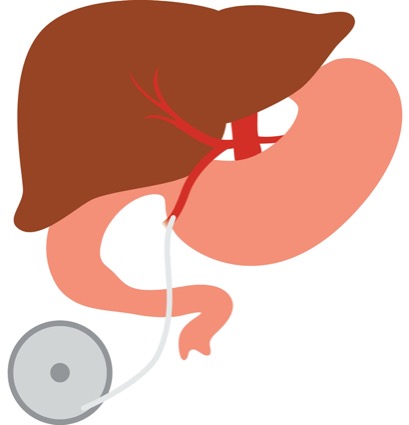In patients with unresectable liver metastases from colorectal cancer, mutated KRAS predicts worse response to hepatic arterial infusion (HAI) pump chemotherapy, according to new research. The findings were presented at the virtual Society of Surgical Oncology 2021 International Conference on Surgical Cancer Care (abstract 39).
“Although not practice changing, our results are important when considering whether to offer this particular treatment to potential candidates with KRAS mutation,” said lead study author Hordur Kolbeinsson, MD, a general surgery resident with Spectrum Health/Michigan State University General Surgery Residency, in Grand Rapids. “Additionally, it suggests that KRAS mutation status should be used as a stratification factor in future trials exploring HAI chemotherapy.”
Previous research showed that KRAS mutation predicts poorer outcomes from resection of colorectal liver metastases and adjuvant HAI pump chemotherapy (Cancer 2014;120[24]:3965-3971). Less is known about the effect of a KRAS mutation on tumor response in patients with unresectable colorectal liver metastases who are treated with HAI pump chemotherapy.
To shed light on this question, Dr. Kolbeinsson conducted a retrospective review to investigate the effects of KRAS mutation on tumor response in patients with unresectable colorectal liver metastases treated with HAI pump chemotherapy. The researchers assessed maximal tumor response and objective response rate (ORR) using CT imaging, and ORR was defined as a cross-sectional reduction in target lesions by greater than 50%.
Dr. Kolbeinsson reviewed cases from 25 patients with unresectable liver metastases from colorectal cancer who were treated with HAI chemotherapy between August 2017 and May 2019. The median age was 59 years and 52% were male. The median number of liver lesions was 12 and nearly all patients (n=24) had prior chemotherapy before starting HAI pump chemotherapy. The median number of cycles administered via HAI therapy was six.
The researchers observed an overall decrease in liver tumor burden of 63.5% with an ORR of 80%, and 40% of patients converted to resectable status. Eleven patients (44%) had KRAS mutation. When compared with wild-type, KRAS-mutated tumors had a lower rate (64% vs. 100%; P=0.03) and magnitude of response (median, 58% vs. 70%; P=0.04). Fewer patients with KRAS-mutated tumors converted to resectable status during HAI pump chemotherapy (two of 11 vs. eight of 13; P=0.05).
“It must be noted that even though patients with KRAS mutations had an average smaller tumor burden decrease (58% vs. 70%), their overall response rate was more than acceptable (64%), meaning that patients with KRAS mutations and unresectable liver metastases from colorectal cancer are still going to benefit from the treatment,” Dr. Kolbeinsson said.
Asked to comment on the study, Timothy Pawlik, MD, MPH, the surgeon-in-chief at The Ohio State Wexner Medical Center and chair of the Department of Surgery in The Ohio State College of Medicine, in Columbus, pointed out that previous studies already identified the importance of KRAS status in predicting prognosis in colorectal liver metastases.
“In particular, work from our own research group has demonstrated the importance of KRAS status relative to systemic chemotherapy, tumor burden score, surgical margin status, patterns of recurrence and overall prognosis,” said Dr. Pawlik, who is also the Urban Meyer III and Shelley Meyer Chair for Cancer Research at The Ohio State University Comprehensive Cancer Center–Arthur G. James Cancer Hospital and Richard J. Solove Research Institute. “The current study builds on this work to demonstrate that KRAS wild type patients had a better response to HAI therapy than KRAS-mutated lesions. This finding would be what we expect as KRAS-mutated tumor generally have a worse prognosis and are typically more aggressive.”
“While provocative, the data would need to be repeated in a larger trial,” Dr. Pawlik said. “This study only included 25 patients and was retrospective in nature. As such, it is difficult to make any true causal inferences. That said, many clinicians already use KRAS status to help make decisions around treatment with chemotherapy, when/whether to operate, as well as inform surveillance strategies. Data from this abstract suggest that KRAS data can also be used to identify who might benefit the most from HAI therapy. Similar to resection and systemic chemotherapy—perhaps not surprisingly—patients with KRAS wild type status benefited the most from HAI.”
Dr. Pawlik also pointed out that the researchers only reported response to HAI. “While response is an important outcome to measure, the authors should have also reported overall survival,” he said. “Although the response following HAI therapy was different among patients who had KRAS wild type versus mutant tumors, was there a difference in overall survival? In addition, while some centers use pump-based HAI therapy, other centers use catheter-based Y-90 (yittrium-90) locoregional therapy. Future studies should examine if KRAS status can similarly predict response to locoregional Y-90 radiotherapy.”
This article is from the July 2021 print issue.



Please log in to post a comment